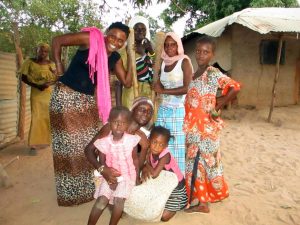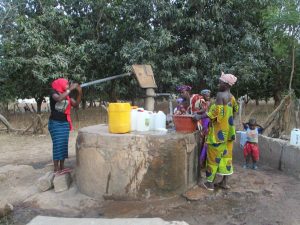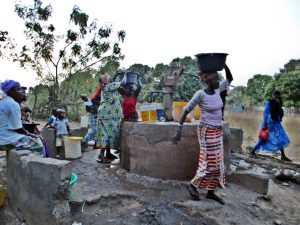This project is made possible through the partnership of WATER CHARITY and the NATIONAL PEACE CORPS ASSOCIATION. ![]()
 Location
Location
This project summary has been redacted for security reasons to omit the specific project location.
Xxxxxxxx, Kiang Central, Lower River Region, The Gambia
Community Description
Kiang Central is one of the six districts of the Lower River Division of the Gambia. It is comprised of about 760 people, including 137 children under 5, the majority of whom are ethnically Mandinka, along with a few Fula constituents.
Most men do farming and most women do gardening and go to the rice field. Farming is the main source of income of most compounds, groundnut being the main cash crop and rice the staple one. The majority of farmers use traditional, subsistence farming methods with little or no modern equipment, and the scant surplus of the crop, if any, that is not used for sustenance is usually sold for a small profit.
Xxxxxxxx has 42 compounds, a lower basic school that consists of two Early Child Development (ECD) classes through grade six, and a health center. The school serves Xxxxxxxx as well as some neighboring villages. Likewise, the health center is a major facility in the district and serves 33 villages.
Both the school and the clinic have boreholes that provide part of the village with non-potable water. The community has 4 stand taps extended by a community member from his compound to the village to supplement an uncovered well used by the community members for their daily domestic use.
Problem Addressed
There is a lack of clean water to solve all of the needs of the village. The village borehole has not been functioning for the past few years. There is a cylinder problem coupled, with a leaking pipe network due to poor construction. The community invested over D100,000 to repair the system, but to no avail.
 Every day, women and girls spend long hours fetching water, and sometimes waiting time involves fights over taking turns.
Every day, women and girls spend long hours fetching water, and sometimes waiting time involves fights over taking turns.
About two months ago, the private borehole that supplies 4 taps to the community, stopped functioning, and consequently, most of the village members now fetch water from a hand pump.
In a sample of 20 girls and women of ages ranging between 7 and above 50, the members spend a total of 83 hours/day (an average of 4 hours each per day) fetching water, 59 hours of which are spent by students.
The Officer-In-Charge (OIC) of Xxxxxxxx Health Centre confirmed that women and children are the most affected in the community by this serious, inadequate supply of clean water.
Project Description
This project is to improve the water capacity and quality in the village by building a water system, as follows:
Install four 250 Watts/24V solar panels
Install a GrundfossSQF5-8A AC/DC pump
Install a metal tower
Install four 2,000 L plastic tanks
Install 348 PVC pressure pipe extensions of 50 mm, connected to 14 one-inch complete taps
Construct a wastewater soakaway
Papa Sanneh, an engineer in Serekunda, surveyed the Village. The community will dig half-meter-deep trenches for installing the pipes, and provide the meals and support for Sanneh’s professional team.
Once the trenches are dug, the team will do the installation. Project funding will provide substantial financing (~75%) for its implementation. The community will contribute about 25% in cash and in-kind of the total cost of the project.
Once the system is installed, every adult in the village will pay 10 Dalasis/month as a maintenance fee.
 During the installation period, the PCV along with counterparts from Xxxxxxxx Health Center will conduct 3 sensitization workshops on hygiene, sanitation, and maintaining the water system at the place where the community meets to take care of the village affairs, in Xxxxxxxx Lower Basic School, and Xxxxxxxx Lower and Upper Basic Junior Secondary School.
During the installation period, the PCV along with counterparts from Xxxxxxxx Health Center will conduct 3 sensitization workshops on hygiene, sanitation, and maintaining the water system at the place where the community meets to take care of the village affairs, in Xxxxxxxx Lower Basic School, and Xxxxxxxx Lower and Upper Basic Junior Secondary School.
Project Impact
800 people in the community, plus students from nearby villages, will benefit from the project.
Peace Corps Volunteer Directing Project
R. Osta
Monitoring and Maintenance
The sustainability of a clean water supply is the goal of this project. Participating in a project and carrying on responsibility is a crucial part of its sustainability. The community will be able to sustain a clean water supply because it has a stake in the project. When a community is a fighting force behind change, it will become engaged, attentive, and respectful of others and the equipment.
The Water Committee will be responsible for monitoring the operation of the new water supply system. It will encourage community collaboration and develop a sense of accomplishment.
Let Girls Learn
This project qualifies as Let Girls Learn project because it addresses access to clean water, a basic need that is essential for quality life, the burden for which falls inordinately upon females. Girls and women will spend less time fetching water and more time taking care of themselves, and on capacity building, including studying, learning new skills and becoming able to generate income to have financial independence and security.
Fundraising Target
$5,500
Funds raised in excess of the project amount will be allocated to other projects in the country.